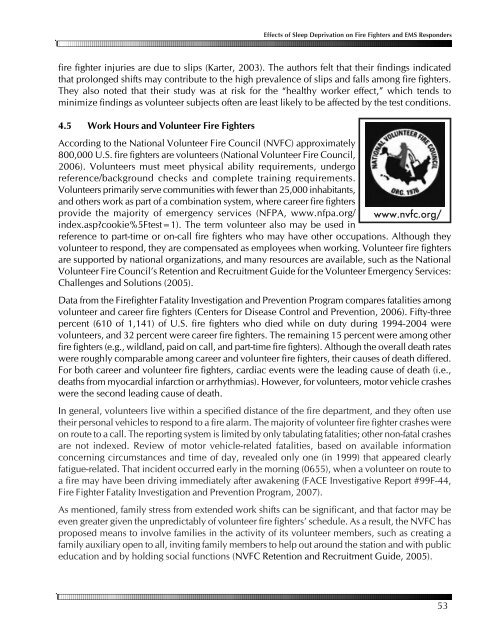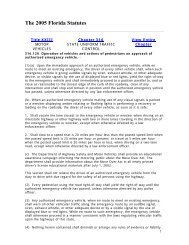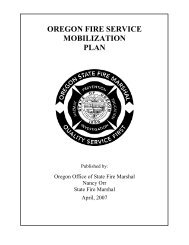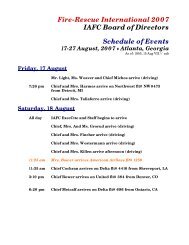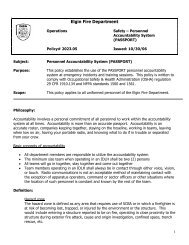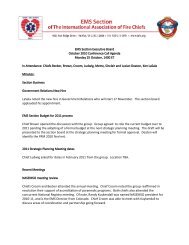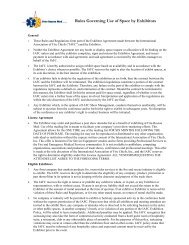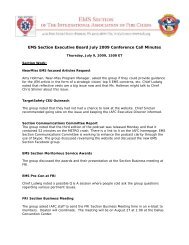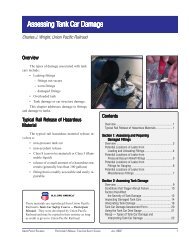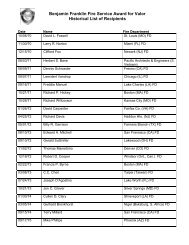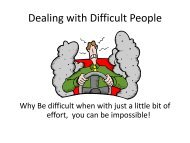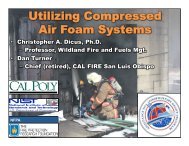Effects of Sleep Deprivation on Fire Fighters and EMS ... - NAEMT
Effects of Sleep Deprivation on Fire Fighters and EMS ... - NAEMT
Effects of Sleep Deprivation on Fire Fighters and EMS ... - NAEMT
Create successful ePaper yourself
Turn your PDF publications into a flip-book with our unique Google optimized e-Paper software.
<str<strong>on</strong>g>Effects</str<strong>on</strong>g> <str<strong>on</strong>g>of</str<strong>on</strong>g> <str<strong>on</strong>g>Sleep</str<strong>on</strong>g> <str<strong>on</strong>g>Deprivati<strong>on</strong></str<strong>on</strong>g> <strong>on</strong> <strong>Fire</strong> <strong>Fighters</strong> <strong>and</strong> <strong>EMS</strong> Resp<strong>on</strong>ders<br />
fire fighter injuries are due to slips (Karter, 2003). The authors felt that their findings indicated<br />
that prol<strong>on</strong>ged shifts may c<strong>on</strong>tribute to the high prevalence <str<strong>on</strong>g>of</str<strong>on</strong>g> slips <strong>and</strong> falls am<strong>on</strong>g fire fighters.<br />
They also noted that their study was at risk for the “healthy worker effect,” which tends to<br />
minimize findings as volunteer subjects <str<strong>on</strong>g>of</str<strong>on</strong>g>ten are least likely to be affected by the test c<strong>on</strong>diti<strong>on</strong>s.<br />
4.5 Work Hours <strong>and</strong> Volunteer <strong>Fire</strong> <strong>Fighters</strong><br />
According to the Nati<strong>on</strong>al Volunteer <strong>Fire</strong> Council (NVFC) approximately<br />
800,000 U.S. fire fighters are volunteers (Nati<strong>on</strong>al Volunteer <strong>Fire</strong> Council,<br />
2006). Volunteers must meet physical ability requirements, undergo<br />
reference/background checks <strong>and</strong> complete training requirements.<br />
Volunteers primarily serve communities with fewer than 25,000 inhabitants,<br />
<strong>and</strong> others work as part <str<strong>on</strong>g>of</str<strong>on</strong>g> a combinati<strong>on</strong> system, where career fire fighters<br />
provide the majority <str<strong>on</strong>g>of</str<strong>on</strong>g> emergency services (NFPA, www.nfpa.org/ www.nvfc.org/<br />
index.asp?cookie%5Ftest=1). The term volunteer also may be used in<br />
reference to part-time or <strong>on</strong>-call fire fighters who may have other occupati<strong>on</strong>s. Although they<br />
volunteer to resp<strong>on</strong>d, they are compensated as employees when working. Volunteer fire fighters<br />
are supported by nati<strong>on</strong>al organizati<strong>on</strong>s, <strong>and</strong> many resources are available, such as the Nati<strong>on</strong>al<br />
Volunteer <strong>Fire</strong> Council’s Retenti<strong>on</strong> <strong>and</strong> Recruitment Guide for the Volunteer Emergency Services:<br />
Challenges <strong>and</strong> Soluti<strong>on</strong>s (2005).<br />
Data from the <strong>Fire</strong>fighter Fatality Investigati<strong>on</strong> <strong>and</strong> Preventi<strong>on</strong> Program compares fatalities am<strong>on</strong>g<br />
volunteer <strong>and</strong> career fire fighters (Centers for Disease C<strong>on</strong>trol <strong>and</strong> Preventi<strong>on</strong>, 2006). Fifty-three<br />
percent (610 <str<strong>on</strong>g>of</str<strong>on</strong>g> 1,141) <str<strong>on</strong>g>of</str<strong>on</strong>g> U.S. fire fighters who died while <strong>on</strong> duty during 1994-2004 were<br />
volunteers, <strong>and</strong> 32 percent were career fire fighters. The remaining 15 percent were am<strong>on</strong>g other<br />
fire fighters (e.g., wildl<strong>and</strong>, paid <strong>on</strong> call, <strong>and</strong> part-time fire fighters). Although the overall death rates<br />
were roughly comparable am<strong>on</strong>g career <strong>and</strong> volunteer fire fighters, their causes <str<strong>on</strong>g>of</str<strong>on</strong>g> death differed.<br />
For both career <strong>and</strong> volunteer fire fighters, cardiac events were the leading cause <str<strong>on</strong>g>of</str<strong>on</strong>g> death (i.e.,<br />
deaths from myocardial infarcti<strong>on</strong> or arrhythmias). However, for volunteers, motor vehicle crashes<br />
were the sec<strong>on</strong>d leading cause <str<strong>on</strong>g>of</str<strong>on</strong>g> death.<br />
In general, volunteers live within a specified distance <str<strong>on</strong>g>of</str<strong>on</strong>g> the fire department, <strong>and</strong> they <str<strong>on</strong>g>of</str<strong>on</strong>g>ten use<br />
their pers<strong>on</strong>al vehicles to resp<strong>on</strong>d to a fire alarm. The majority <str<strong>on</strong>g>of</str<strong>on</strong>g> volunteer fire fighter crashes were<br />
<strong>on</strong> route to a call. The reporting system is limited by <strong>on</strong>ly tabulating fatalities; other n<strong>on</strong>-fatal crashes<br />
are not indexed. Review <str<strong>on</strong>g>of</str<strong>on</strong>g> motor vehicle-related fatalities, based <strong>on</strong> available informati<strong>on</strong><br />
c<strong>on</strong>cerning circumstances <strong>and</strong> time <str<strong>on</strong>g>of</str<strong>on</strong>g> day, revealed <strong>on</strong>ly <strong>on</strong>e (in 1999) that appeared clearly<br />
fatigue-related. That incident occurred early in the morning (0655), when a volunteer <strong>on</strong> route to<br />
a fire may have been driving immediately after awakening (FACE Investigative Report #99F-44,<br />
<strong>Fire</strong> Fighter Fatality Investigati<strong>on</strong> <strong>and</strong> Preventi<strong>on</strong> Program, 2007).<br />
As menti<strong>on</strong>ed, family stress from extended work shifts can be significant, <strong>and</strong> that factor may be<br />
even greater given the unpredictably <str<strong>on</strong>g>of</str<strong>on</strong>g> volunteer fire fighters’ schedule. As a result, the NVFC has<br />
proposed means to involve families in the activity <str<strong>on</strong>g>of</str<strong>on</strong>g> its volunteer members, such as creating a<br />
family auxiliary open to all, inviting family members to help out around the stati<strong>on</strong> <strong>and</strong> with public<br />
educati<strong>on</strong> <strong>and</strong> by holding social functi<strong>on</strong>s (NVFC Retenti<strong>on</strong> <strong>and</strong> Recruitment Guide, 2005).<br />
53


